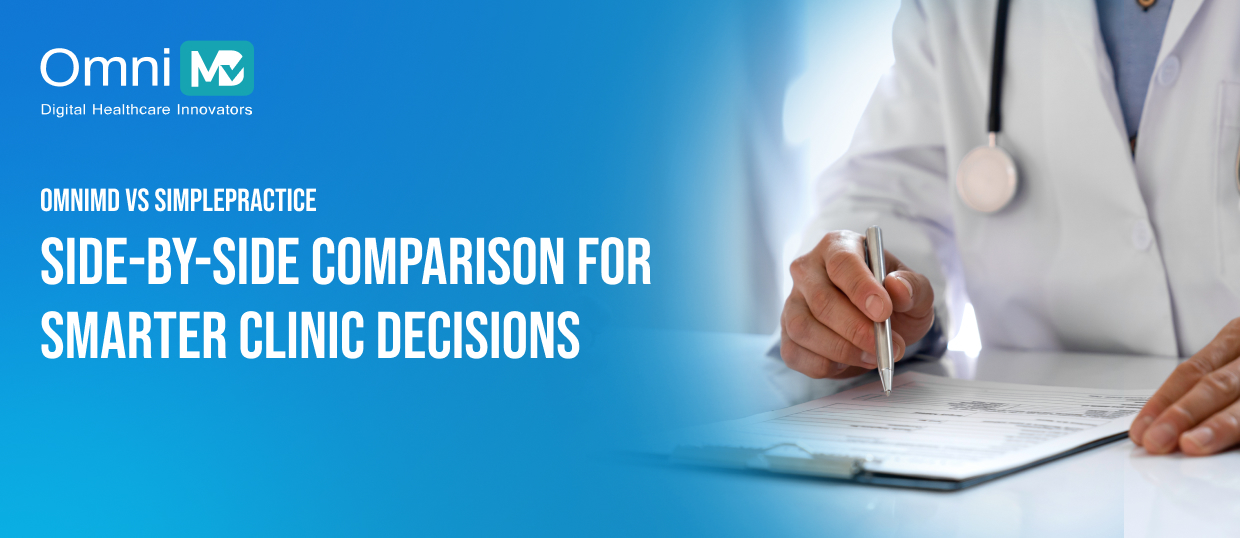OmniMD vs SimplePractice Which Platform Really Builds a High-Growth Practice?

If you’re choosing software for a clinic that expects to grow, the choice is never between two products. It’s between two philosophies.
In other words, it’s between staying small and simple or building a scalable, revenue-driven clinic infrastructure.
This page walks you through both platforms (OmniMD and SimplePractice) with a clear history, strategic positioning, numbers, and real growth logic, so that you, as a clinic owner, administrator, or physician, can decide with confidence.
Where They Come From
SimplePractice Is Born From the Needs of Solo Therapists
SimplePractice started in 2012, created by a therapist who wanted everyday private-practice work to be easier.
Its core mission focused on making scheduling, documentation, billing, and telehealth manageable for independent clinicians.
Over time, it became one of the most popular practice-management tools in behavioral health, with more than 225,000 clinicians using it for mental-health and wellness workflows.
Its design language speaks strongly to solo practitioners and small group practices.
SimplePractice’s product roadmap has centered on private practice needs. It optimizes for ease over deep enterprise complexity.
OmniMD Is Built as a Solo And Multi-Specialty, Revenue-Centric Health IT Platform
OmniMD was founded in 2001 with a different starting point: build a technology-enabled digital health platform that works just as seamlessly for solo providers as it does for growing, multi-specialty medical groups.
Over more than 20 years in healthcare IT, OmniMD has evolved into a portfolio of 18+ products serving 20+ specialties, including cardiology, urgent care, primary care, internal medicine, psychiatry, pediatrics, and more.
Its ecosystem now spans EHR, practice management, RCM, AI tools, BI & analytics, and clinic marketing.
The company positions itself as a growth platform for clinics, with a strong emphasis on revenue optimization, interoperability, and AI-driven automation.
Its long tenure in healthcare IT is reinforced by industry recognition and awards, and its DNA is enterprise-oriented from day one.
Who Each Platform Really Serves
As a clinician, when you buy software, you look for more than features. You look for an operating ecosystem. Let’s see where OmniMD and SimplePractice fit in this expectation.
SimplePractice Is The Best Fit for Simple, Therapist-Led Private Practices
SimplePractice serves:
- Solo therapists and counselors
- Small behavioral-health or wellness practices
- Clinicians who want minimal setup and low administrative complexity
Its core win is accessibility.
The platform offers a clean interface, straightforward workflows, and a contained feature set aligned with the behavioral-health segment.
SimplePractice fits best when the ambition is to run a stable, focused private practice rather than build a multi-specialty, multi-location medical group.
OmniMD Is the Best Fit for Clinics Focused on Scale, Revenue, and Multi-Specialty Growth
OmniMD serves:
- Solo therapists and counselors
- Small behavioral-health or wellness practices
- Multi-provider clinics
- Specialty practices (cardiology, vascular, urgent care, family medicine, mental health, etc.)
- Groups planning new locations, new lines of service, or rapid expansion
Its architecture brings together:
- EHR and practice management
- Full RCM and medical billing services
- AI Front Desk for automating 60+ front office tasks
- AI Medical Scribe for automated clinical documentation
- AI-driven RCM and claim optimization
- BI & analytics for operational KPIs and revenue intelligence
- Clinic marketing services for patient acquisition and brand growth
We, at OmniMD, align with practices that view technology as a growth engine, and not merely a digital filing cabinet.
OmniMD vs SimplePractice Through a Growth Lens
| Category | SimplePractice | OmniMD |
| Primary Origin | Launched in 2012 by a therapist to simplify private practice admin. | Founded in 2001 as a healthcare IT platform for multi-specialty clinics, revenue-driven operations, and now AI-powered workflows. |
| Typical User | Solo clinicians, small behavioral-health or wellness practices. | Multi-provider clinics, specialty groups, urgent care, multi-location networks, and now increasingly solo and small clinics adopting AI for efficiency. |
| Specialty Scope | Strong in mental health and wellness. | 20+ specialties including cardiology, urgent care, primary care, internal medicine, psychiatry, pediatrics, and more, with specialty-specific templates and AI scribe models that cut charting time by 40 to 60%. |
| Practice Size Fit | Optimized for small practices and simple group setups. | Built for both single clinics and multi-site organizations, lightweight enough for solo practices, powerful enough to scale. |
| Billing & RCM Depth | Integrated billing for private practice workflows. | Full RCM services, AI-driven claim accuracy, denial prediction, and advanced revenue analytics, helping even small clinics improve collections by 15 to 25% and reduce denials at the source. |
| AI Capabilities | Limited automation around documentation and front desk. | AI Front Desk, AI Medical Scribe, AI RCM, and AI Clinician tools that automate intake, documentation, verification, and revenue workflows, reducing front desk workload by up to 50% and eliminating after-hours charting. |
| Analytics & BI | Basic reporting for private practice needs. | BI & analytics with drill-down KPIs on denials, missed charges, utilization, productivity, and revenue, helping small clinics run like high-performance businesses. |
| Marketing Support | Focused on operations rather than growth marketing. | Optional clinic-marketing services: SEO, content, campaigns, conversion-focused websites, giving small clinics enterprise-level marketing without hiring an agency. |
| Interoperability | Suitable for standalone private practices. | Designed for interoperability, labs, and enterprise-grade connectivity, while remaining lightweight for solo setups. |
Each row in this table weaves two stories.
One says “run my private practice smoothly.”
The other says “build and scale a high-performing clinical business.”
How Your Choice Plays Out Over 3 to 5 Years
Scenario 1: Solo or Small Behavioral-Health Practice
Profile:
- 1 to 5 providers
- Primarily therapy or counseling
- Limited expansion plans
Historically:
SimplePractice has offered a fast path from paper to digital: online booking, telehealth, billing, and a client portal with lightweight setup.
But the landscape has changed.
Small practices are now adopting AI to reduce manual tasks and extend their capacity without hiring more staff.
In this scenario, OmniMD is no longer ‘more than you need’, it actually gives you measurable advantages:
- AI Scribe reduces charting time by 40 to 60%, eliminating late-night documentation.
- AI Front Desk handles check-ins, forms, insurance verification, and reminders, reducing admin load by ~50%.
- AI RCM reduces errors and denials, helping small practices protect revenue without needing billing staff.
- Specialty templates (therapy, psychiatry, counseling) make visit notes faster and more consistent.
Outcome:
Even a solo clinician can operate with the efficiency of a 3 to 4 person team, without the cost.
Scenario 2: Growing Specialty Clinic
(Cardiology, Urgent Care, Primary Care, Multi-Specialty Group)
Profile:
- 5 to 25+ providers
- Multiple specialties or services
- Focus on reducing denials, optimizing collections, and automating workflows
In this profile:
SimplePractice can support scheduling and documentation but is primarily designed around behavioral health and small practice simplicity.
OmniMD fits more tightly because growth requires automation:
- AI Medical Scribe reduces after-hours charting and frees clinician time.
- AI Front Desk automates calls, check-ins, eligibility checks, and intake tasks.
- AI RCM boosts first-pass rates, predicts denials, and automates follow-ups.
- BI & Analytics provide insights into revenue per visit, denial causes, productivity, and utilization.
- Specialty EHR models ensure accuracy for cardiology, urgent care, IM, pediatrics, and more.
Outcome:
OmniMD turns daily operations into measurable revenue levers. This matters exponentially more as:
- provider count grows
- visit volume increases
- denials become costlier
- multiple locations launch
Scenario 3: Multi-Location Network or Single-Site Clinic Preparing to Expand
Profile:
- Strong ambition to open new branches or add multiple specialties
- Desire to integrate EHR, RCM, AI automation, front-desk operations, and marketing under one ecosystem
- Leadership focused on standardizing workflows and accelerating growth
For this profile:
SimplePractice
SimplePractice remains a solid fit for satellite behavioral-health teams that need straightforward practice management.
However, its architecture is not optimized as an enterprise backbone, especially when you introduce:
- multiple specialties
- high claim volume
- multi-location scheduling
- centralized billing
- advanced reporting
- AI-assisted operations
It can support early growth, but teams often hit limitations once expansion accelerates.
What Drives a Growth-Focused Decision
A high-growth clinic evaluates software with questions like:
- How many more patients can each provider see when documentation and intake are automated?
- How many denials can be prevented when AI checks claims before submission?
- How much leadership clarity is gained when revenue KPIs, scheduling trends, and bottlenecks are visible in real time?
- How much marketing spend becomes more effective when patient acquisition and clinical operations sit on the same data foundation?
SimplePractice supports better organization for thousands of small practices. Its contribution lies in lowering friction for clinicians who previously juggled paper, spreadsheets, or fragmented tools.
OmniMD couples clinical documentation, AI agents, billing operations, claims intelligence, analytics, and marketing into a unified platform. Its contribution lies in improving throughput, revenue integrity, and decision-making quality at the practice or network level.
From a 3 to 5 year financial perspective, the question becomes less “Which screens look cleaner?” and more:
Which platform will extract more value from every patient interaction, every claim, and every marketing dollar?
In small, stable practices, SimplePractice can be entirely sufficient. In ambitious, growth-oriented medical groups, OmniMD becomes structurally better aligned to the outcomes leadership cares about.
Let our experts walk you through a scalable and impactful revenue-generating model.
Book a demo now!

See Why Clinics Choose OmniMD Over SimplePractice
Get a live walkthrough of the features that improve speed, workflows & growth.